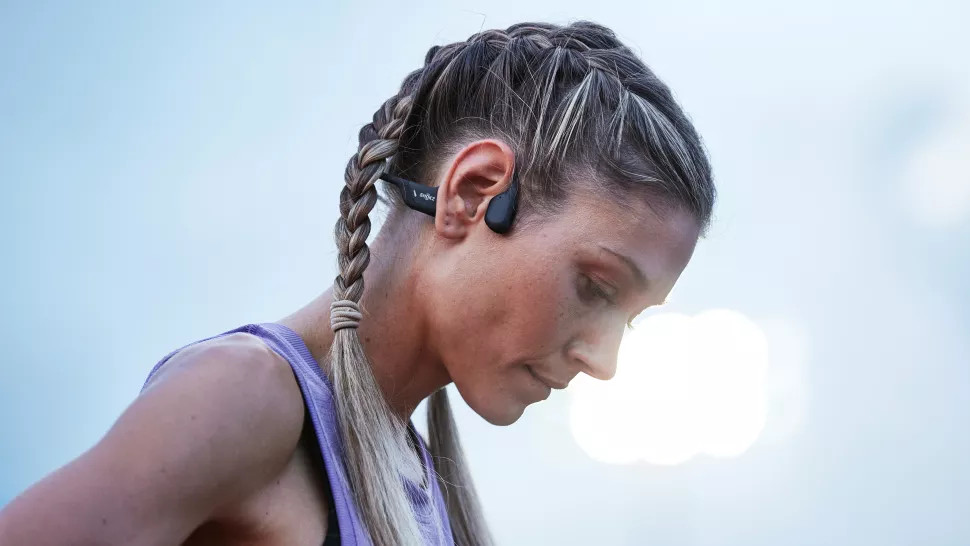5 types of headphones for running
Tune in at any pace with these running headphones

If you’re a runner that loves to rock out to your favorite playlist, or enrich your brain with a little podcast action while you’re out on the roads or the trail, there’s no doubt that you’ll want a good pair of running headphones. These days, however, there are so many different types to choose from.
Do you want headphones that cancel out all other noise or a pair that let you know when a car is coming up behind you? Do you want the best listening experience possible, or is lightweight packability the most important feature to you? In this article, we walk you through five of the main types of headphones for running so that you can tune in at any pace.

1. Over-ear headphones
If you’ve been around for a while, over-ear headphones are basically the original headphone, with a plastic headband and speakers that partially or fully cover your ears.
Because these headphones don’t go inside your ear, they’re widely considered one of the most comfortable types of headphones. They are unlikely to fall off while you’re running and provide the best listening experience.
That said, they’re obviously not the lightest type, nor are they particularly packable, though you can at least wear them around your neck when you’re not using them. They do eliminate ambient noise making them a hazard for busy roads or shared use trails, and they can get a bit sweaty when you’re running.

2. In-ear headphones
These are exactly what they sound like – headphones that extend into your ear canal. The part that goes inside your ear is usually covered with silicone for comfort. These are really common, lightweight and easy to carry in the pocket of your running jacket, and they can be really affordable too. The sound quality can be pretty good, although don’t expect these to be akin to over-ear headphones.
However, there are also some drawbacks for runners – primarily, you won’t be able to hear any ambient noise like traffic on the roads or a mountain biker coming up behind you on the trail. If you have a wired model, when the wire subs against your running top, that noise may get picked up by your headphones and slightly ruin your listening experience. They’re also considered the least hygienic and can get pretty waxy with use.
Advnture Newsletter
All the latest inspiration, tips and guides to help you plan your next Advnture!

3. Earbuds
Earbuds are similar to in-ear headphones, and in fact that might be what you think of when someone says in-ear headphones, but there is actually a slight difference. Earbuds are made from hard plastic and do not actually extend into your ear canal, though they do sit just inside your ear. If you own an iPhone, you’ll have a pair of earbuds that came for free with your phone.
Like in-ear headphones, earbuds are lightweight and easy to cart around, and the sound quality is pretty good. Some that are “smart” will even allow you to take phone calls while you’re wearing them, though make sure you’re staying in zone 2 if you're trying to conduct meetings while you’re running. Earbuds will let in a little more ambient noise than in-ear headphones, which makes them a little safer for running outdoors, though a little less desirable for listening experience.
The main downsides of earbuds are that the hard plastic can become pretty uncomfortable if you’re wearing them for a long run, and because they don’t sit all the way inside your ear they can fall out more easily which means they can get lost if they’re wireless.

4. Open-ear headphones
Much as the name suggests, open-ear headphones don’t block your ear canal at all, allowing runners to hear ambient noise and rock out at the same time. These have a hook that goes over the top of your ear, and a small speaker that sits near your ear canal.
The most basic open-ear headphones just have a speaker that sits near your ear, while technological advances have produced subtypes of open-ear headphones, such as bone conduction headphones, which we’ll cover below.
In general, open-ear headphones are thought to be more hygienic, since they don’t get all waxy in your ear or transmit dirt from your pocket into your ear, and of course they allow for more ambient sound which is thought to be safer for runners. They won’t fall out, unless you’re doing a headstand, and they usually come in a small charging case to keep them safe when you’re not using them.
However, it’s safe to say that the sound quality isn’t as great as it is with headphones that go inside, or completely cover your ears.

5. Bone conduction headphones
Bone conduction headphones like the Shokz OpenRun Pro are a type of open-ear headphones that are becoming increasingly popular among runners. These are a subtype of open-ear headphones, that loop over the top of your ears, while the speaker rests on your cheekbone just in front of your ear.
Hit play and the headphones send vibrations through your cheekbones and straight to the cochlea in your inner ear, bypassing your ear canal, eardrum, and the three tiny bones (the hammer, anvil, and stirrup) that usually transmit vibrations from the air.
Bone conduction headphones stay a lot cleaner than any model that goes inside your ear and they’ll never fall out, plus you can always hear what’s going on around you. However, the sound quality may not yet be as good as other types of headphones on this list, and because of the vibration, you may prefer to keep them on at a lower volume, which can further reduce your listening experience.
Julia Clarke is a staff writer for Advnture.com and the author of the book Restorative Yoga for Beginners. She loves to explore mountains on foot, bike, skis and belay and then recover on the the yoga mat. Julia graduated with a degree in journalism in 2004 and spent eight years working as a radio presenter in Kansas City, Vermont, Boston and New York City before discovering the joys of the Rocky Mountains. She then detoured west to Colorado and enjoyed 11 years teaching yoga in Vail before returning to her hometown of Glasgow, Scotland in 2020 to focus on family and writing.

